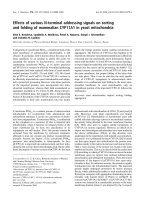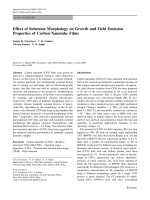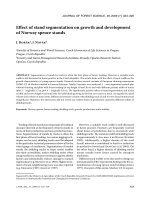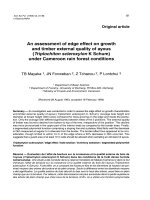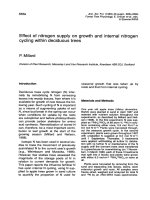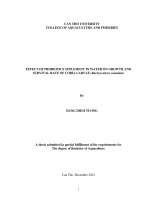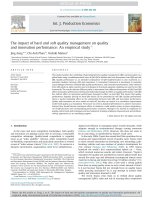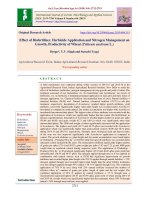Effect of various method of weed management on growth and yield of vegetable pea (Pisum sativum. spp. Hortense. L) involving the use of implements and herbicides
Bạn đang xem bản rút gọn của tài liệu. Xem và tải ngay bản đầy đủ của tài liệu tại đây (269.13 KB, 7 trang )
Int.J.Curr.Microbiol.App.Sci (2019) 8(3): 521-527
International Journal of Current Microbiology and Applied Sciences
ISSN: 2319-7706 Volume 8 Number 03 (2019)
Journal homepage:
Original Research Article
/>
Effect of Various Method of Weed Management on Growth and Yield of
Vegetable Pea (Pisum sativum. spp. Hortense. L) Involving the Use of
Implements and Herbicides
Vikram Singh1, Kuldeep Kumar2, Pradip Kumar Saini4*,
Ankit Singh Chauhan1 and D.P. Singh1
1
Department of Horticulture, 2Department of Vegetable Science, 3Department of Crop
Physiology, Chandra Shekhar Azad University of Agriculture and Technology, Kanpur (U.P.),
4
Narendra Deva University of Agriculture and Technology,
Kumarganj, Ayodhya (U.P.), India
*Corresponding author
ABSTRACT
Keywords
Weed management,
Herbicides and
Vegetable pea
(Pisum sativum spp.
hortense. L)
Article Info
Accepted:
07 February 2019
Available Online:
10 March 2019
Vegetable pea (Pisum sativum spp. Hortense L.) is an important pulse crop. In the present
investigation, afield experiment was laid out in randomized block design in three
replication Variety - Azad Pea-3, keeping pre-emergence application of pendimethalin
(stamp extra 38.7%) @ 0.75 kg a.i./ha, stale seed bed glyphosate @1.00 kg a.i./ha,
mulching and hand weeding in plot. This field experiment was carried out at Kalayanpur,
Kanpur during Rabi season 2014-15 and laboratory test were also conducted. Data display
that the weed free check method treatment yielded. The highest seed yield of vegetable pea
closely followed by hand weeding at 20, 40 and 60 DAS. The lowest seed yield was found
in weedy check (no weeding). The seed yield of vegetable pea in other treatment was
recorded in between these two limits. The growth and yield trials were supported to the
seed yield but the maximum BCR was computed under pre-emergence application of
pendimethalin (stamp extra 38.7%) @ 0.75 kg a.i./ha.
Introduction
Vegetables are richest source of nutrition of
the large part of vegetarian demography at the
global level. In India, vegetable contribute
about 8-10% edible food intake which is
distressingly low as compared to Japan where
its share is about 45%. The estimated
availability of vegetable in India is around
145-185 gram per capita per day while
neutralist advocate 285-300 gram of vegetable
in the balance diet. Pulses are gaining more
important position in Indian agriculture. After
the Green Revolution, India became self
sufficient in food grain production. However,
India is still lagging behind in pulses
production and is dependent on imports for
domestic consumption in present days. As
521
Int.J.Curr.Microbiol.App.Sci (2019) 8(3): 521-527
there is little scope to increase area under
pulses, the production can be increased by
enhancing the productivity by various agrotechniques. Pea contains nutritional value per
100gram (3.5 oz) energy 339 kJ (81kcal),
carbohydrates 14.45 g, sugars 5.67g, Dietary
fiber 5.1 gram, fat 0.4g, protein 5.42 g,
Vitamin A equiv. 38 µg, beta carotene 449 µg,
lutein zeaxanthin 2.477µg, Thiamine (B1)
0.266 mg, Riboflavin (B2) 0.132 mg, Niacin
(B3) 2.09mg, Vitamin (B6) 0.169mg, Folate
(B9) 65 µg, Vitamin C 40 mg, Vitamin E
0.13mg, Vitamin K 24.8 µg, Calcium 25 mg,
Iron 1.47 mg, Magnesium 33 mg, Manganese
0.41mg, Phosphorus 108 mg, Potassium
244mg, Sodium 5 mg and zinc 1.24 mg.
(USDA
Nutrient
Database).Integrated
approach of weed management is always
welcomed. Chemical control integrated with
cultivations, rotation and hand weeding
increase crop yield (Tu et al., 1993). Pre–
emergence of application 0.5 kg/ ha
pendimethalin + hand weeding (30DAS) or
0.5 kg fluchloralin as pre sowing + hand
weeding (30 DAS) have been found better for
weed control and pea yield as compared to
herbicides alone (Sharma and Vats 1986).
Materials and Methods
The experiment was carried out at department
of vegetable science Kalyanpur, C. S. Azad
University of Agriculture and Technology
Kanpur during the year 2015-2016. Field
experiment was laid out in R.B.D, having
three replication and nine treatments and
Variety - Azad Pea-3, keeping pre-emergence
application of pendimethalin (stamp extra
38.7%)@ 0.75 kg a.i./ha, stale seed bed
glyphosate @1.00 kg a.i./ha, mulching and
hand weeding in plot. T1 – Pre-emergence
(PE) application of pendimethalin (stamp
extra 38.7%) @ 0.75 kg a.i./ha.T2- Preemergence (PE) application of pendimethalin
(stamp extra) 0.75 kg a.i./ha Followed by one
hand weeding at 40DAS.T3- Stale seed bed by
glyphosate @ 1.00 kg a.i./ha at (15 days
before sowing because sowing time for all the
treatment will same). T4- Stale seed bed by
glyphosate @ 1.00 kg a.i./ha Followed by one
hand weeding at 40DAS. T5-Mulching with
Black polythene.T6-Straw mulch or grass
mulch.T7- Hand weeding at 20, 40 and 60
days after sowing.T8-Weed free check
method. T9-Weedy check (No weeding) The
highest seed yield of vegetable pea closely
followed by hand weeding at 20, 40 and 60
DAS. The vegetable research farm is about 10
km away from Kanpur central railway station
in the north western part of the Kanpur city. It
is situated in the front of Indian institute of
Pulse Research Geographically, Kanpur is
situated in gangatic alluvial belt of Central
Uttar Pradesh and located between
25°26ˈto26°28ˈnorth latitude and 79°31ˈto
80°34ˈ East longitude at elevation of
127.00meters above mean sea level.
Results and Discussion
The relavant research studies on improvement
of production potential in pea in respect of
integrated weed management are meagre and
hence the present investigation is aimed to
increase the growth and yield attributes in pea
with use of chemical, mulching and hand
weeding.
Height of plant
Effect of different treatments on height of the
plants has been presented from sowing date to
maturity of plants from table 1. Observation
pertaining to the height of plant since very
beginning was affected by the treatments had
manifested the maximum height of the
vegetable pea at all the stages of observation.
It was clearly indicated that the height of plant
mainly governed by weed free check method.
Such result is in the conformity with the work
of. (Rana et al.,2007, Channappagoudar and
Birader et al., 2007, Yousefi et al.,
522
Int.J.Curr.Microbiol.App.Sci (2019) 8(3): 521-527
2007,Travlos et al.,2014 and Shiv Chandrakar
et al.,2015) (Fig. 1).
Seed weight per plant
It is clear from the data that the seed weight
per plant, from table 1. Increased significantly
in weed free check method followed by hand
weeding at 20,40 and 60 days after sowing.
Seed weight per plant is the resultant growth
of plant. Data represented for these characters
in previous chapter also showed that this
treatment has shown its superiority with
respect to over all other treatments. The result
obtained in this investigation was supported
by (Ved Prakash et al., 2000, Emenky et al.,
2010, Olorunmaiye, 2010, Brij Bhooshan and
Singh, 2014 and Onuh et al., 2015)
Number of seeds per pod
Number of seeds per pod as affected by the
treatments has been presented in table 2. It is
clear from the table the superiority of weed
free check similar followed by pre emergence
application of pendimethalin (stamp extra)
@0.75kg a.i./ha followed by one hand
weeding at 40 DAS. Other treatments which
are alone could not make any marked
differences in results. Number of seeds per
pod character is a dependant on length of pods
of Vegetable Pea here it is clear that sufficient
number of seeds per pod is available on plant
according to plant growth. Weed free check
method clearly indicates that besides pre
emergence application of pendimethalin
(stamp extra) @0.75kg a.i./ha followed by one
hand weeding at 40 DAS plays the role in
increasing the number of seeds per pod. This
result has also corroborated Ramesh Verma et
al., (2014) (Fig. 2).
100 Seed weight (gm)
100 seed weight as recorded in this
experiment has been presented in table 2. This
indicate that weed free check method has over
all superior over other treatments. Although
there was no much difference among the
treatments over this characters. The higher
100 seed weight (gm) of treatment weed free
check method is only because of the bigger
seed size. Results also conform with the result
of Gutiérrez et al., (2001), Emenky et al.,
(2010) and Madukwe et al., (2012).
Table.1 plant height and seed weight/plant recorded under different treatments
Treatments
Pre-emergence ( PE) application of pendimethalin(stamp extra 38.7%)@0.75
kg a.i./ha .
Pre-emergence ( PE) application of pendimethalin(stamp extra 38.7%)@0.75
kg a.i./ha . Followed by one hand weeding
Stale seed bed by glyphosate @1.00kg a.i./ha at 15 days before sowing
Stale seed bed by glyphosate @1.00kg a.i./ha Followed by one hand weeding
at 40 DAS
Mulching with black polythene.
Straw mulch/ or grass mulch.
Hand weeding at 20, 40 and 60 DAS
Weed free check method
Weedy check (no weeding)
CD 5%
CV%
523
Plant height
(cm)
53
Seed
weight/plant(gm)
12.05
58
12.20
50
47
9.60
10.20
54
53
58
60
49
4.48
3.51
12.20
12.35
12.80
13.45
7.90
1.01
3.72
Int.J.Curr.Microbiol.App.Sci (2019) 8(3): 521-527
Table.2 No. of seeds /pod and 100 seed weight (gm)
Treatment
Pre-emergence ( PE) application of pendimethalin(stamp extra 38.7%)@0.75 kg
a.i./ha .
Pre-emergence ( PE) application of pendimethalin(stamp extra 38.7%)@0.75 kg
a.i./ha . Followed by one hand weeding
Stale seed bed by glyphosate @1.00kg a.i./ha at 15 days before sowing
Stale seed bed by glyphosate @1.00kg a.i./ha Followed by one hand weeding at
40 DAS
Mulching with black polythene.
Straw mulch/ or grass mulch.
Hand weeding at 20, 40 and 60 DAS
Weed free check method.
Weedy check (no weeding)
CD 5%
CV%
No. of seeds
/pod
6.45
100 Seed
weight (gm)
30.20
6.50
30.55
4.55
4.76
24.10
25.53
6.35
6.26
6.46
6.56
4.75
0.16
1.12
30.52
30.95
32.05
33.82
19.75
1.24
1.82
Table.3 Seed yield (Q/ha)
Treatment
Seed yield (Q/ha.)
Pre-emergence ( PE) application of pendimethalin(stamp extra 38.7%)@0.75 kg a.i./ha .
14.98
Pre-emergence ( PE) application of pendimethalin(stamp extra 38.7%)@0.75 kg a.i./ha .
Followed by one hand weeding
Stale seed bed by glyphosate @1.00kg a.i./ha at 15 days before sowing
15.17
Stale seed bed by glyphosate @1.00kg a.i./ha Followed by one hand weeding at 40
DAS
Mulching with black polythene.
Straw mulch/ or grass mulch.
Hand weeding at 20, 40 and 60 DAS
12.65
Weed free check method
Weedy check (no weeding)
CD 5%
CV%
16.75
9.76
0.55
1.63
11.93
15.15
15.35
15.93
Fig.1 Plant height (cm) and seed weight/plant (gm) influenced by different treatments
524
Int.J.Curr.Microbiol.App.Sci (2019) 8(3): 521-527
Fig.2 No. of seeds/pod and 100 seed weight (gm) recorded under different treatments
Fig.3 Seed yield/ha
with the work of Vaishya et al., (1999),
Tiwari and Tiwari (2002) and Muhammad et
al., (2014).
Seed yield per hectare
The seed yield per hectare as affected by the
different treatments have been presented in
table 3 observation pertaining to the highest
seed yield per hectare was found in the
treatment of weed free check method (Fig. 3).
In conclusion, on the basis of result of the
present investigation made during winter
season 2014-15, the following conclusion
may be drawn as per objective. Plant height
effected by the treatments had manifested the
maximum height of the vegetable plant
indicate that the height of plant was maximum
in weed free check method. Seed weight
showed that this treatment has sown its
It was clearly indicated that the seed yield per
hectare mainly governed weed free check
method. It was also clear that the lowest seed
yield per hectare in weedy check (no
weeding). Such results were in the conformity
525
Int.J.Curr.Microbiol.App.Sci (2019) 8(3): 521-527
superiority with respect to all other
treatments. Number of seeds per pod clearly
indicates that besides pre emergence
application of pendimethalin (stamp extra)
@0.75kg a.i. /ha followed by one hand
weeding at 40 DAS, plays the role in
increasing the number of seeds per pod. Seed
yield clearly indicate that the seed yield per
hectare mainly governed weed free check
method. It was also clear that the lowest seed
yield per hectare in weedy check (no
weeding). Observation represented that the
weed free check method treatment yielded.
Highest kernel yield of vegetable pea closely
followed by hand weeding at 20, 40 and 60
DAS. The growth and yield trial were
supported to the yield but the maximum BCR
was
computed
under
pre-emergence
application of pendimethalin (stamp extra
38.7% @ 0.75 kg a.i./ha).
University of Duhok, Kurdistan
Region, Iraq. Pakistan Journal of
Weed Science Research 16(2): 189198.
Gutiérrez, W., Medrano, C., Villalobos, Y.,
Medina, B., Narváez, J.;Martínez, N.,
Montiel, R., Higuera, A.and Báez, J.
(2001). Weed control on cowpea
(Vigna unguiculata (L.)) Walp under
direct sowing in Maracaibo plateau,
Venezuela. RevistaUnellez de Ciencia
y Tecnología, ProducciónAgrícola 19:
115-124
Madukwe, D. K., Ogbuehi, H. C., Onuh, M.
O (2012). Effects of weed control
methods on the growth and yield of
cowpea (Vigna unguiculata (L.) Walp)
under rain-fed conditions of owerri.
American-Eurasian
Journal
of
Agricultural
&
Environmental
Sciences 12 (11): 1426-1430
Mohammad Amin, Khan, M. J., Jan, M. T.,
Abdul Latif, Masood-ur-Rehman and
MohammadArif
(2014).
Weed
biomass and growth of mungbean as
affected by tillage practices and
sowing methods. Sarhad Journal of
Agriculture 30 (2) 227-230
Olorunmaiye, K. S.(2010) Reproductive
performance of two cowpea (Vigna
unguiculata (L) Walp) varieties Ife
brown and TVX3236 as influenced by
Imidazolinone and Dinitroaniline
herbicides. Australian Journal of
Agricultural Engineering 1(3): 101105.
Onuh, M. O., Ukonu, E. N., Ibe, A. E.,
Madukwe, D. K. and Iheaturu, D. E.
(2015). Performance of cowpea
(Vigna unguiculata (L) Walp) as
influence by different weed control
methods.
Journal
of
Biology,
Agriculture and Healthcare 5(17):
178-185.
Ramesh Verma, Nepalia, V. and Kumawat, S.
K. (2014). Influence of weed control
Acknowledgments
The authors are thankful to the Department of
Horticulture (Vegetable), Chandra shekhar
Azad University of Agriculture and
Technology, Kanpur, for supporting and
funding to develop the present research.
References
BrijBhooshan and Singh, V.K (2014). Effect
of planting method, irrigation schedule
and weed management practice on the
performance
of
fieldpea
(Pisumsativum L. arvense). Journal of
Food Legumes 27(2): 112-116
Channappagoudar, B.B. and Biradar, N.R.
(2007). Physiological approaches for
weed management in soybean and
redgram (4:2 RP) intercropping
system. Karnataka Journal of
Agricultural Sciences 20(2): 241-244.
Emenky, F. A. O., Khalaf, A. S. and Salim, N.
M.
(2010).
Department
of
Horticulture, College of Agriculture,
526
Int.J.Curr.Microbiol.App.Sci (2019) 8(3): 521-527
and sulphur nutrition on weed
dynamics and productivity of pea
(Pisum sativum L.). Indian Journal of
weed Science 36 (3/4 ): 285-286.
Rana, M. C., Amar Singh, Rana, S. S.and
Naveen Kumar (2007). Integrated pest
management in pea (Pisum sativum)
under Lahaul valley conditions of
Himachal Pradesh. Indian Journal of
Agricultural Sciences 77 ( 1 ): 59-61
Sharma,A.R. and Vats, O.P (1986) Indian
journal Agron., 33: 214-216
Shiv Chandrakar, Akanksha Sharma, and
Gajendra
Chandrakar
(2015).
Response
of
integrated
weed
management to different varieties of
chickpea (Cicer arietinum L.). Trends
in Bioscience 8(3): 833-835.
Tewari, A. N. and Tiwari, S. N.
(2002).Chemical
control
of
Asphodelus tenuifoliusin testing gram
under rainfed condition. Indian J. of
Agril. Sci. (communicated).
Travlos, I. S., Kanatas, P. J., Tsioros, S.,
Papastylianou, P., Papatheohari, Y.
and Bilalis, D. (2014). Green manure
and pendimethalin impact on oriental
sun-cured tobacco. Agronomy Journal
106 ( 4): 1225-1230
Tu, H et al.,(1993) Scientia Agricultura Sinica
26: 49-56.
Vaishya, R. D., Rai, O. P. and Singh, R.
K.(1999). Weed control in field pea
with pre and post emergence
herbicides. Indian Journal of Pulses
Research 12(2): 201-205.
VedPrakash, Pandey, A. K., Singh, R. D. and
Mani, V. P. (2000). Integrated weed
management in gardenpea under midhills of north-west Himalayas. Indian
Journal of Weed Science 32(2): 7-11.
Yousefi, A.R. Alizadeh, H.M. and Rahimian,
H. (2007). Broad leaf weed control in
chickpea (Cicer arietinum L.) with
pre-and post-emergence herbicides.
Research on Crops 8 (3): 560-564
How to cite this article:
Vikram Singh, Kuldeep Kumar, Pradip Kumar Saini, Ankit Singh Chauhan and Singh, D.P.
2019. Effect of Various Method of Weed Management on Growth and Yield of Vegetable Pea
(Pisum sativum. Spp. Hortense. L) involving the Use of Implements and Herbicides.
Int.J.Curr.Microbiol.App.Sci. 8(03): 521-527. doi: />
527
